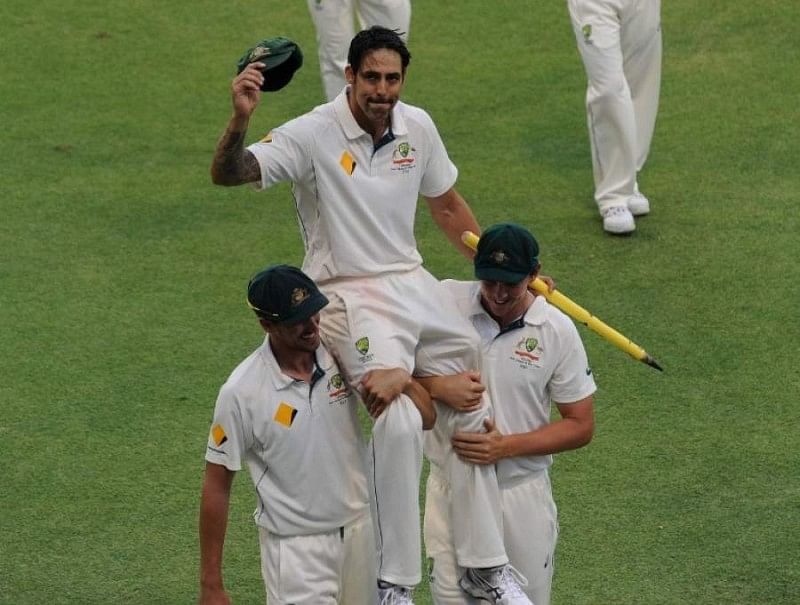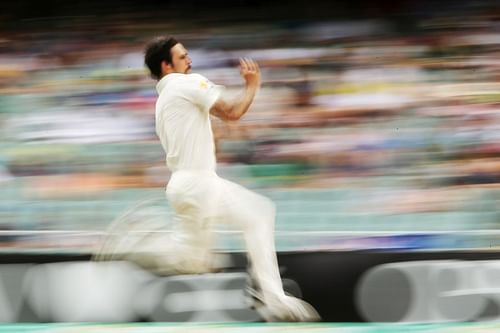
Five reasons why Mitchell Johnson was the last of the generation of feared fast bowlers
As Mitchell Johnson walked off into the sunset after the draw in the second test between Australia and New Zealand, the game of cricket has become poorer without him. In the age where batsmen rule the roost with their immense bats on flat pitches, Johnson was the lone spark who was left in the ever-diminishing quota of good fast bowlers. It was perhaps fitting that he took the only two New Zealand wickets to fall in the second innings – both to bouncers. With that, he finished as Australia’s fifth highest wicket taker of all time, and certainly one of their most dangerous.After a poor debut in which he went for 1-157 against New Zealand, Johnson roared back with several impressive spells in both Tests and ODIs. Though he never reached great heights in the shorter format of the game, he was feared in the longer version. After Brett Lee, Glenn McGrath and Michael Kasprowicz announced their retirement from test cricket, it was left to be seen who would take on the mantle of Australia’s pace spearhead. It was then that Mitchell Johnson came roaring into the national side. Johnson, who wasn't even picked for the Cricket World Cup in 2007, would emerge as Australia’s best modern-day bowler.But pure pace alone never made a bowler threatening. Dale Steyn was menacing, but he slowly lost his pace over time. Morne Morkel was quicker than him, but he never looked particularly dangerous while he was bowling. But Mitchell Johnson rose above them all. He combined pace with aggression, menace with skill and accuracy with variation to go down as one of the best of all time.Let’s take a look at 5 reasons why Johnson was so feared by all:
#5 Speed Machine

Stories of how bowlers sacrificed pace to increase longevity are plenty in the modern game. Take Chaminda Vaas, Zaheer Khan or even Dale Steyn – they were all quick bowlers who shaved off a few miles per hour from their speed to ensure that they don’t lose the battle between the body and the game. Perhaps in the long run, it was the wise move. Stories of fast bowlers’ careers being ended by injuries are also rife – Shaun Tait, Shane Bond and Simon Jones come to mind. But there are bowlers still, who withstood the test of time and fatigue and came out on top, just as fast and menacing as they originally were. Mitchell Johnson was one such bowler.
Bounding in with a piercing glare, a vampirish face and a dragon tattoo, Mitchell Johnson was the cricketing equivalent of a sports car – lean, mean and a fighting machine. His left-arm roundarm was the first thing batsmen noticed, and it always gave them the appearance that the ball would move away from them. But Johnson learnt to swing it back in, which accounted for the best of batsmen thanks to his raw pace. When a good line and length didn’t bowl, Johnson stacked on the pace, dropping it shorter and shorter till the batsman danced around the pitch, trying not to make their faces a target.
Johnson also mastered the surprise delivery – only in his case, it was the yorker, not the bouncer. Once his trusty bouncer had been used enough, Johnson would sling it at the batsman’s toes, which would eventually get the poor man out LBW. Unlike regular bowlers who dropped pace with every over, Johnson kept cranking it up after every ball, as though wondering why the batsman was not yet running in fear. At the age of 33, when most fast bowlers would either enjoy a quiet cup of tea at home or turn into medium-fast bowlers, Johnson was bowling at 151 kmph to the South Africans en route to his 12 for 127 in Centurion last year.
Johnson’s terrifying visage only added to the aura of invincibility that seemed to emanate from him, and it definitely helped the cause. His 37 wickets in the 2013-14 Ashes series was his best, which included wicket tallies of 9, 8, 6, 8 and 6 in each test. Despite Australia putting in a team effort to win it 5-0, it will always be remembered for Mitchell Johnson running in with a handlebar moustache and ending up as a blur on the pitch.